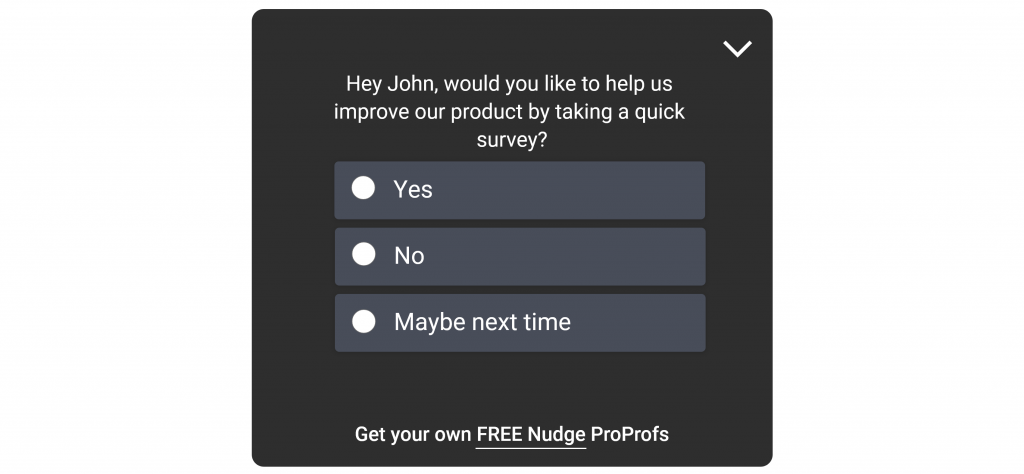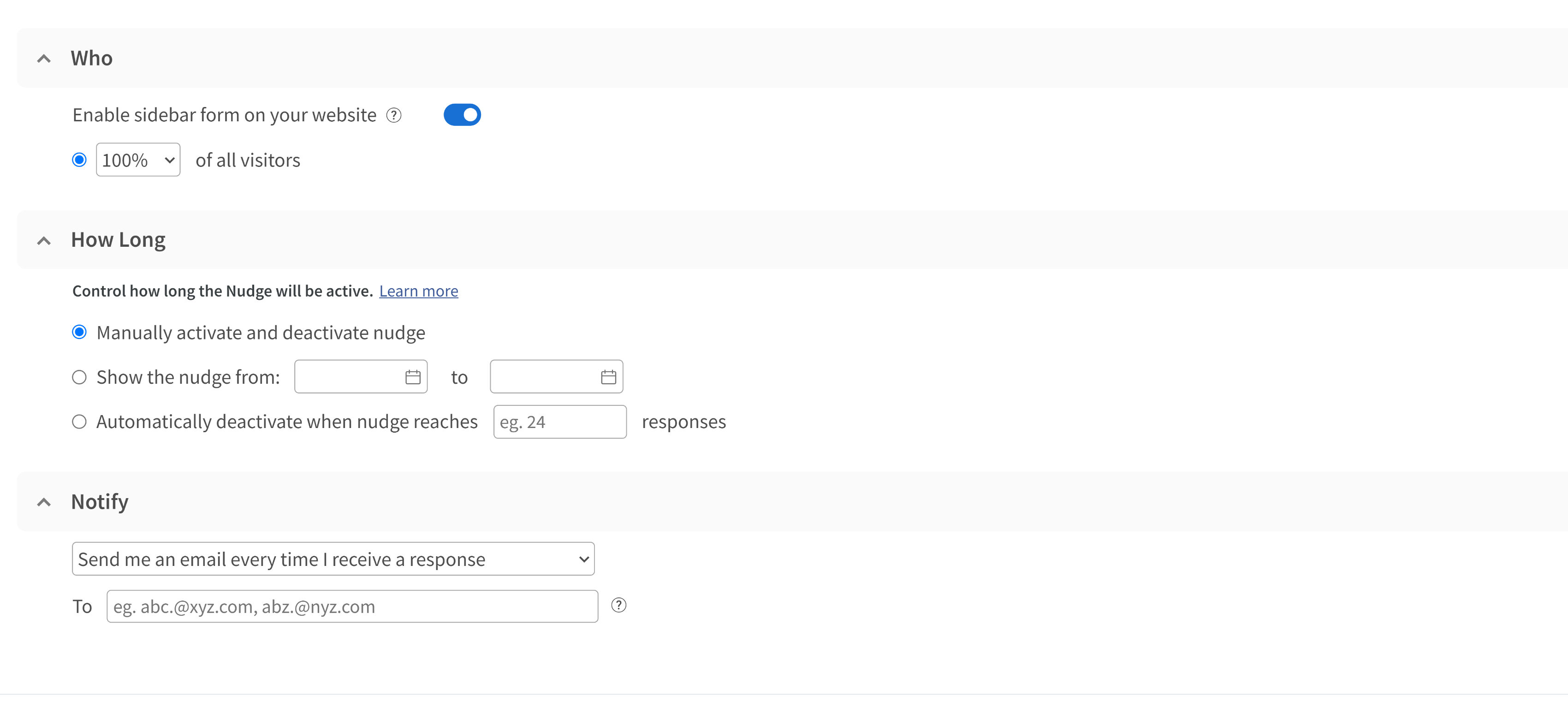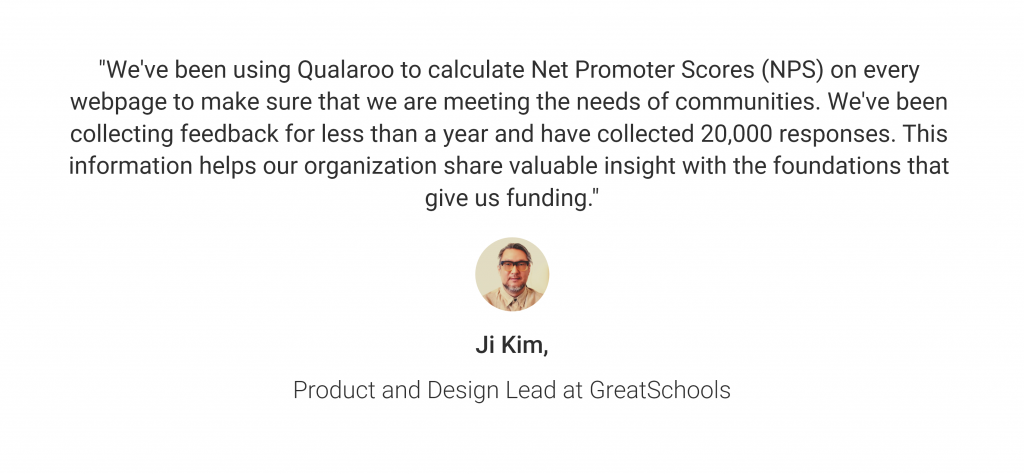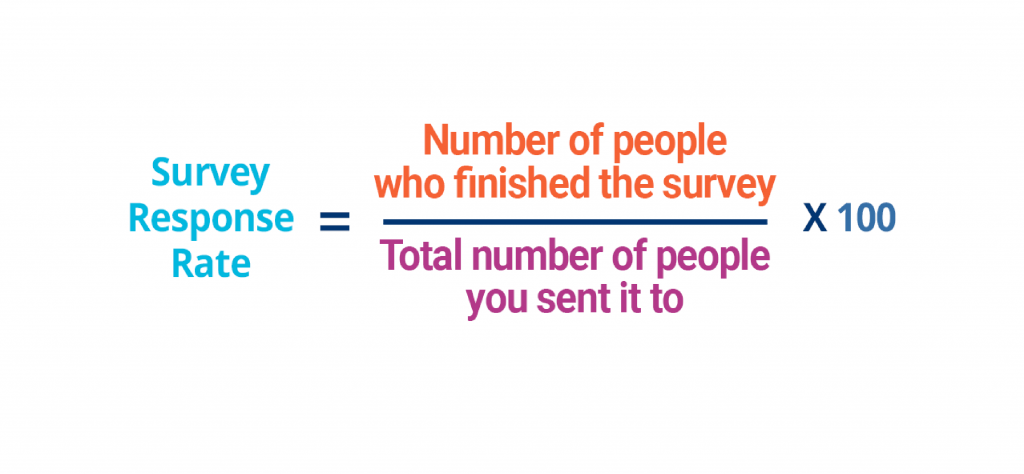
It’s not unusual to not generate enough responses in online surveys.
There can be multiple reasons for this. Either the survey is too long, not relevant to the respondents, the motive behind the survey is unclear, or there is no incentive for the respondents.
Whatever the reason, it can help you to know how to influence your respondents to take surveys.
To ensure that your surveys don’t end up being just another marketing message your customers receive every day, I gathered some effective strategies to increase survey response rates.
So, let’s dive right in.
What Is a Survey Response Rate?
A survey response rate refers to the percentage of people who responded to a survey out of the total number of people who were invited or eligible to participate. It is a measure of the level of engagement or interest from the survey recipients.
Generally, a higher response rate is considered better as it means a larger sample size was obtained, and the survey results are therefore more representative of the population being studied.
However, the ideal response rate may vary depending on the survey goals, the target population, and the survey methodology used
What Is Considered a Good Survey Response Rate?
A good survey response rate can vary widely depending on several factors, such as the target population, survey distribution method, the topic of the survey, how the survey is administered, and the statistical validity required for the results.
Qualaroo surveys offer a versatile feedback solution with response rates ranging from 3% to 30%. In-context surveys typically achieve higher rates (10-30%) due to their immediate placement within the user experience.
As for academic research, higher response rates above 60% are usually sought to ensure the data’s validity and to reduce non-response bias.
How to Increase Your Survey Response Rates: 13 Useful Tips
You can improve your survey response rates through several methods. They include:
- Creating personalized survey templates
- Being considerate toward respondents
- Giving them a gentle nudge for participation
- Using multiple channels to deliver surveys
- Offering incentives to respondents
- Segmenting the customers & targeting the right audience
- Not being repetitive and over-surveying the audience
- Send surveys at the perfect time
- Keep it short and sweet
- Make your surveys mobile-friendly
- Be clear about survey length
- Use simple, clear language
- Focus on active customers
Let me elaborate on each of them:
1. Create Personalized Survey Templates
When it comes to offering exemplary services and uplifting customer experience, organizations are pushing the boundaries and setting new standards. This is why customers nowadays want personalized services from brands and would not settle for anything less than that.
In fact, 86% of consumers say personalization has a significant impact on their purchasing decisions.
This evidently shows that incorporating personalization in every aspect of online surveys is now a necessity.

Remember: Using a simple personalization technique, such as addressing the respondents by their first name and asking open-ended questions, would proportionately increase the average survey response rates.
2. Be Considerate Toward Your Respondents
Consider this: Would you be interested in participating in a survey that asks never-ending questions, most of which are not even relevant to you?
Most definitely not.
Similarly, the survey respondents would never consider taking a survey that either consumes a lot of time or has nothing to do with what they are doing on the web.
This is something that can be easily fixed by knowing what to ask the customers and, most importantly, when.
What's the Best Time to Send an Online Survey?
According to HubSpot, it's best to send an online survey on a low-peak time weekday. They include early mornings, lunchtime, late afternoons, and after-work evenings. It reduces the chances of your surveys getting lost among other work-related emails and increases the likelihood of your targets completing them.
3. Give Them a Gentle Nudge for Participation
Customers don’t normally consider participating in a survey as their top priority. Some of the respondents might even forget to participate after receiving a survey.
This is the reason why giving your respondents a gentle reminder at regular intervals is necessary.
This can be done by setting up automated survey Nudges™, which would discreetly pop on the screen of customers and remind them about their survey participation.
This is a completely unobtrusive way of sending reminders known to increase the survey response rates without hurting the morale of the customers.
4. Use Multiple Channels to Deliver Surveys
The channel that you use to communicate with your audience is another crucial factor when it comes to surveying. Two of the most common and highly responsive survey channels include:
- On-site/in-app surveys
- Email surveys
By using these channels, the frequency of surveys can be increased, and customers are more likely to participate, which they would have initially avoided or missed.
You can start posting your surveys on social media and integrate them on relevant websites, which would significantly increase your coverage and footprint over the internet.
This way, you are essentially making the customers ‘run into you’ by already being available where they are likely to visit.
5. Offer Incentives to Respondents
Customers are more likely to participate in a survey when the reward for participation is worth the effort put in by them. For example, monetary rewards are known to increase the average response rate by over 19% and non-monetary rewards by almost 8%.
With incentives, such as gift cards and raffles, people might even just rush through the surveys to get those incentives.
Although these incentives mean increased costs for a company, the increased response rate you may get ultimately makes it worthy of investment.
Bonus Read: Customer Loyalty Guide – How to Measure & Improve it
6. Segment Your Customers & Target the Right Audience
To get the most accurate representation of your survey data, you should make sure that you only survey a specific demographic.
By asking the right audience, you not only get precise information but also increase the response rate.

Source: ProProfs
You can also base your segmentation on the customer lifecycle stage, which would help your surveys wisely target the right set of audiences at the right time. Therefore, understanding the nature of your survey and the positioning of your customers is an important consideration.
There are several ways you can target your customers for surveys. Here are some of them:
- Targeting based on behavior
An effective way of targeting your respondents is through their online behavior. This would include factors like:
- The website they came from
- Number of times they visited
- Search engine they use
- Targeting based on location
Another way of targeting customers is by choosing a certain geographic location website.
- Targeting based on time
Choosing the timing of your survey is also crucial, and here, you can decide when you want to display your survey to the respondents. You can time your surveys like this:
- Immediately after the page loads
- After a specific time period
- When it looks like visitors might abandon the page
- Targeting based on frequency
Targeting can also be determined based on the number of times a survey is displayed. This would include factors like:
- Once per visitor
- Continue showing until the respondent answers
- Recurring surveys after a stipulated time period
7. Do Not Be Repetitive & Over-Survey the Audience
Increasing the frequency of the surveys is one thing, but over-surveying is another. Bombarding your audience with the surveys will only end up alienating them instead of generating any meaningful response.
I understand that collecting feedback from customers at every touchpoint is extremely frustrating from the customer’s perspective. That’s why you should thank the customer at every step and set parameters for the surveys to only pop up after a set duration.
You should also use survey throttling to stop particular surveys from popping up again for the same customers. By doing so, you would allow the customers to take their time and process all the information, along with making them curious about survey participation.
That was all about how to increase survey response rates. Let’s now further understand other related topics.
8. Send Surveys at the Perfect Time
Timing is a critical factor in survey response rates. Schedule your survey emails for times when your audience is most likely to be available and attentive. For example, mid-morning (around 10-11 AM) and mid-afternoon (2-3 PM) during weekdays are often ideal because people have settled into their workday and are less likely to be overwhelmed by tasks.
Avoid early Monday mornings when people are catching up from the weekend or late Friday afternoons when they are winding down for the week.
Additionally, consider your audience’s time zones if they are globally distributed, and use A/B testing to pinpoint the best times for your specific demographic.
9. Keep It Short and Sweet
Long surveys can deter respondents, leading to lower completion rates and potentially less reliable data. Aim to keep your survey under 5 minutes, which generally means fewer than 10 questions.
Prioritize questions that will yield the most valuable insights and eliminate any that are redundant or non-essential. For instance, instead of detailed multiple-choice questions for each product feature, ask a general rating question and follow up with an open-ended question for additional comments.
This approach respects your respondents’ time and makes it more likely they will complete the survey.
10. Make Your Surveys Mobile-Friendly
With the growing use of mobile devices, it’s essential that your surveys are optimized for smartphones and tablets. This means using a
responsive design that adjusts to different screen sizes and touch interfaces. Use large, easy-to-tap buttons and minimize the need for extensive scrolling.
For example, instead of long text fields, use rating scales, multiple-choice questions, and yes/no questions that are easier to navigate on a mobile device. A mobile-friendly survey ensures that respondents can complete it conveniently, regardless of where they are, leading to higher response rates.
11. Be Clear About the Survey Length
Setting clear expectations at the beginning of your survey helps manage respondents’ time and reduces the likelihood of abandonment. Start your survey with a brief message such as, “This survey will take approximately 3 minutes to complete.”
This transparency builds trust and reassures respondents that their time commitment is minimal. Additionally, include a progress bar to visually indicate how much of the survey remains, which can motivate respondents to finish the survey.
12. Use Simple, Clear Language
Clear and straightforward language is crucial for ensuring respondents understand your questions and provide accurate answers. Avoid technical jargon, acronyms, or complex sentences that could confuse respondents.
For example, instead of asking, “How would you rate the efficacy of our customer support communication protocols?” ask, “On a scale of 0-10, how satisfied are you with our customer support?” Simple, direct questions reduce cognitive load and improve the quality of the responses you receive.
13. Focus on Active Customers
Regularly clean and update your contact list to ensure you are targeting active and engaged customers. Remove contacts who have not interacted with your brand in the past six months or who have unsubscribed from your communications.
This practice ensures that your surveys reach individuals who are more likely to respond and provide relevant feedback. For instance, if you’re surveying customers about a recent product launch, focus on those who have recently made a purchase or engaged with your brand.
Engaged customers are more likely to provide thoughtful and actionable insights, improving the overall quality of your survey data.
Importance of Surveys & Participation
Online surveys are a great way for you to get up to speed with how customers perceive your product or service. But that’s just the tip of the iceberg as there are several other advantages as well.
- Surveys Talk in Numbers
The survey responses that you collect provide statistical data on how the customers feel about a product or service and to what extent. Surveys are more than just story-telling as they represent accurate opinions and behavior of the masses.
- They Help in Benchmarking
Surveys are actively used by businesses to make critical decisions. These decisions are based on the statistical data provided by the surveys that allow organizations to set progression goals and benchmarks.
- They are Cost-Effective
Online and email surveys are some of the most cost-effective ways of gathering user data. The total cost per respondent is almost negligible, and even when you add the incentive, the overall cost would still be substantially less than when administering paper surveys.
- They Offer Flexibility
When you account for all the ways you can conduct a survey, there are a plethora of them, including online surveys, mobile surveys, social media surveys, email surveys, paper surveys, telephonic surveys, etc. You can always deploy different types of surveys based on the audience’s characteristics, which makes them an extremely flexible choice.
- They Help Analyze Trends
By surveying your audience, you get a bigger picture and also a clear understanding of the ongoing trends in the world. This would allow you to stay ahead of the curve and understand hidden needs.
For example, if a company’s net promoter score (NPS) ratings drop significantly, appropriate changes can be made to the website or the services the business offers, and benchmarks can be set to acquire ratings above a certain threshold.
If you would like to create your own NPS survey, we’d suggest this video guide:
How to Create Net Promoter Score Survey with Qualaroo
Case Study
Founded in 1998, GreatSchools is an American national non-profit organization that created a school quality rating system based on the school resources, student outcomes, and the ratings provided by the school residents.
The vision of GreatSchools is not to make profits but to lead American parents, students, organizers, schools and policy makers toward a promising future.
Therefore, gathering information to expand their insights on educational needs and parents’ attitudes is always a challenge.
Non-profit organizations often struggle with gathering the resources needed to learn about the communities they intend to serve. On-site visits and user testing aren’t always feasible or inexpensive, which adds up to the challenge.

By deploying Qualaroo to collect NPS on every webpage, GreatSchools was able to capitalize on fast feedback to make themselves as robust as any other entity.
As a result, GreatSchools collected more than 20,000 responses in less than a year. This helped the organization design a website that everybody preferred and share valuable insights with the foundation that provided them funding.
How Is a Survey Response Rate Calculated?
The survey response rate is calculated by dividing the number of completed surveys by the number of eligible respondents and then multiplying by 100 to express it as a percentage. This rate is a key indicator of the engagement level of your targeted population and the representativeness of your survey results.
Here’s the formula:

Number of Completed Surveys: This is the count of surveys that were fully completed by respondents.
Number of Eligible Respondents: This includes all individuals who were selected and invited to participate in the survey and were eligible to do so. It’s important to exclude from this count anyone who was found to be ineligible after the selection process, such as due to incorrect contact information or no longer fitting the survey criteria.
The calculation does not consider partially completed surveys unless specified by the survey’s methodology. The distinction between fully and partially completed surveys is significant for certain types of analysis and reporting.
Improving the survey response rate can be crucial for ensuring the collected data is representative of the entire population.
Techniques to improve response rates include simplifying survey questions, reducing the survey length, offering incentives, sending reminders, and ensuring the survey is accessible to all targeted respondents.
What Factors Impact Survey Response Rates the Most?
Several key factors can significantly impact your survey response rates. Understanding and addressing these elements can help you design more effective surveys and gather valuable feedback.
- Survey Design and Layout
A cluttered and confusing survey layout can immediately turn respondents away. A clean, user-friendly design makes all the difference.
You should utilize plenty of white space, consistent fonts, and a professional look. Approach your survey like a friendly conversation; the more visually appealing it is, the more inviting it will be. Instead of presenting a wall of text, try breaking up the question into multiple short questions.
- Survey Relevance and Timing
Timing and relevance are crucial for capturing accurate feedback. If someone just purchased a product, sending them a survey while the experience is fresh in their mind can be very effective.
For instance, a quick follow-up email a few days after delivery, asking about their satisfaction, can provide timely and relevant insights. This ensures that the questions resonate with their recent experience, making the feedback more precise and valuable.
- Ease of Completion
No one enjoys a survey that feels like a maze. So, ensure your survey is easy to navigate with clear instructions and a logical flow. You can use simple question formats, like multiple-choice or rating scales, are quicker to answer and avoid confusion. This seamless user experience encourages respondents to complete the survey without frustration.
Bonus Read: What Is Survey Fatigue & How to Avoid It – a Step by Step Guide
- Follow-Up Strategy
Sometimes, a gentle reminder is all it takes to encourage survey completion. Sending a polite follow-up email to those who haven’t responded can significantly boost your response rates.
For instance, you can send a reminder a week after the initial invitation, emphasizing the importance of their participation and providing a quick link to the survey. Ensure the reminder is friendly and respectful of their time.
- Anonymity and Confidentiality
Trust is essential for honest feedback. Assure respondents that their answers will remain anonymous and confidential. For example, include a statement like, “Your responses will be kept confidential and used only for improving our services.” This assurance helps build trust and encourages more candid responses, as people feel safer sharing their true opinions.
Also check out: What Is an Anonymous Survey & How to Create One
Bonus Tips to Generate Good Survey Response Rates
Find out additional strategies on how to increase survey participation.
- Only ask questions that your audience can relate to or have information pertaining to that subject.
- To get a better understanding of effective survey questions, feel free to take a look at this resource.
- Keep the questions to a minimum without compromising any information. For example, if you are able to gather all the needed information from 5 questions, don’t include any more questions as they can then become redundant.
- Use skip-logic to send the respondents down the right path quickly. This would allow you to eliminate responses that add no value to your results.
- Make use of short questions and mainstream vocabulary for easy understanding.
- Use small incentives for each respondent instead of big incentives for some.
- Be transparent with your audience and let them know how the data will be used.
- Tell the respondents why you chose them for the survey.
- Allow the respondents to compare their responses with their peers.
Increase Survey Response Rates Dramatically!
When you’re planning to deploy a survey, always be mindful of the nature and components of your survey. Having a better understanding of your survey and the audience would enable you to make the most of a given opportunity.
Also, if you are looking for a survey tool for yourself, make sure you check out Qualaroo. It’s a highly intuitive survey tool that gives you contextual customer insights.
With professionally built templates paired with features like branching logic and exit intent surveys, it is the most comprehensive surveying tool that you will ever need.
FREE. All Features. FOREVER!
Try our Forever FREE account with all premium features!





